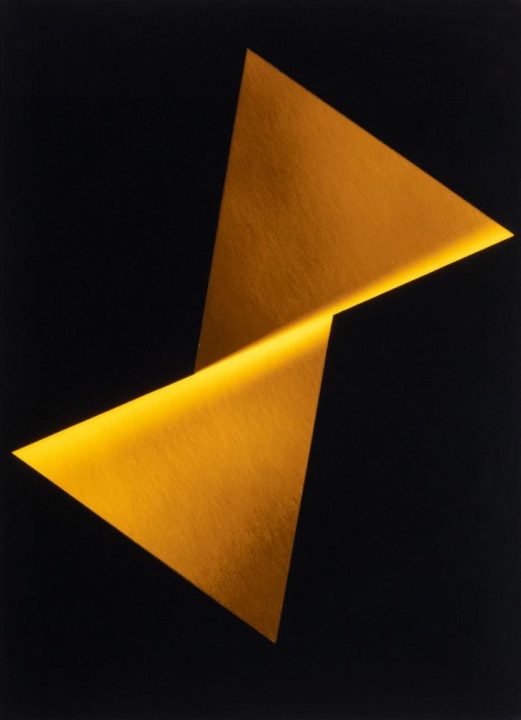Lorne St Grand Opening

Andrew Beck,
Broken Image 2, 2019
acrylic, enamel, gelatin
silver prints
and conservation glass in artist's
frame
400 × 290 mm
Combining digitally generated
images with traditional chemical photographic printing
processes, Andrew Beck produces fractured, dispersed
entities that play on the idea of the art object as a body,
a corporeal form subject to degradation and decay. He
relates this to the status of the digital image, itself an
uneasy passenger that becomes diffuse and unclear through
its iterative versioning and reproduction. The title,
Image Atrophy, refers to this concept of an image
breaking up, losing its fidelity, becoming noisy and
uncertain.
Beck’s process of collaging and recombining his images invites comparisons to the polymorphic, amorphous nature of internet image repositories such as Google Image Search and Instagram. In these chaotic virtual libraries, the individuality of the image is brought into question as each entry bleeds and folds into those around it, becoming lost in a deluge of information that approaches the status of chaos.
As a way of thinking through the implications of the digital fragmentation of images, Beck has created several works that refer to the Boids computer simulation, a 1980s program designed to model the way flocks of animals move together. Beck uses these works to visualise the constantly growing and changing multitude of digital images circulating online, a formless mass moving and flowing but never assuming a settled form.
Deploying references to retro-futurist aesthetics drawn from ’90s digital culture, Beck suggests that in these fever-dream visions of unconsummated futures, there are points of slippage and ambiguity that shed light on contemporary anxieties and dilemmas.
Something other,
held in common takes its title from a diary entry Toss
Woollaston wrote in 1962, in which he discusses the
negotiation between making a representational image of a
given location and capturing the experience or feeling of
that place. In that entry, he meditates on the reservoir of
associations that go into building a sense of place, and the
way our understanding of the vertical and horizontal
elements of a composition is informed by our familiarity
with the floors, walls, trees or horizon of our lived
experience. He muses that "something other, but enriched by
the life held in common above the material or physical
likeness of shape, seems to be what is wanted."
For Hannah Valentine, Woollaston’s mark-making is the catalyst for a consideration of associative fields in sculptural form. His use of landscape raises the question of how to engage with the natural world when the dominant narratives concerning it necessarily center on its fragility and precarious future. Woollaston provides an example of how rythmic, intuitive application of an artistic medium (oil in his case, bronze in Valentine’s) can generate an artistic vocabulary grounded in the bodily and the experiential, but open-ended enough to converse with the complexity and scale of contemporary environmental crises.
Valentine describes the resulting works as "a series of bodily imprints," evoking the idea of a felt response to landscape, rather than an observational or detached stance. In these works, Valentine advances the idea that a personal responsibility for and connection to the landscape is a necessary pre-requisite for meaningful steps towards a sustainable future. By incorporating works from the Woollaston estate into the exhibition, Valentine offers the viewer a chance to examine the interleaving architectonic masses of Woollaston’s work for themselves, and to consider how the topological pressures of these paintings are reinterpreted through Valentine’s bronzes.
Hours
10am—6pm
Tuesday to
Saturday
ends


 National Youth Theatre: 140 Christchurch Kids Shine In National Youth Theatre’s Historic CATS Premiere
National Youth Theatre: 140 Christchurch Kids Shine In National Youth Theatre’s Historic CATS Premiere NZ Symphony Orchestra: NZSO To Tour Masterworks By Mozart, Beethoven, Haydn And More
NZ Symphony Orchestra: NZSO To Tour Masterworks By Mozart, Beethoven, Haydn And More Journal Of Public Health: Vape Shops Cluster Around Schools
Journal Of Public Health: Vape Shops Cluster Around Schools Timaru District Council: Aigantighe Art Gallery Hosts An Iconic Robin White Touring Exhibition
Timaru District Council: Aigantighe Art Gallery Hosts An Iconic Robin White Touring Exhibition Victoria University of Wellington: Dame Winnie Laban Awarded Honorary Doctorate Recognising Achievements For Pasifika
Victoria University of Wellington: Dame Winnie Laban Awarded Honorary Doctorate Recognising Achievements For Pasifika  HESSA: This Isn’t Fair—And It’s Time To Fix It - HESSA Petition Calls For Inclusive Student Sports
HESSA: This Isn’t Fair—And It’s Time To Fix It - HESSA Petition Calls For Inclusive Student Sports